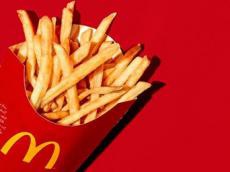|
|
TODAY.AZ / Weird / Interesting
What exactly is in McDonald’s French fries?
23 July 2014 [14:09] - TODAY.AZ
 POTATOES
POTATOESMickey D’s uses varieties like the Russet Burbank, which have a nice oval shape and just the right balance of starch and sugar. Excess sugar can cause a fry to have brown spots where it’s over-caramelized, leaving a burnt taste and deviating from the uniform yellow-arches color. Just in case, the spuds are blanched after slicing, removing surplus sugar.
SODIUM ACID PYROPHOSPHATE
Taters can turn a nasty hue even after they’re fried—iron in the spud reacts with the potato’s phenolic compounds, discoloring the tissue. The phosphate ions in SAPP trap the iron ions, stalling the reaction and keeping the potatoes nice and white throughout the process.
VEGETABLE OIL
In the good old days, McDonald’s fries were cooked in beef tallow. But customer demand for less saturated fat prompted a switch to vegetable oil in the early ’90s. Here, that means oils of varying saturations combined into something reminiscent of beef tallow. There’s canola (about 8 percent saturated fat), soybean oil (16 percent), and hydrogenated soybean oil (94 percent). And to replace the essence of beef tallow? “Natural beef flavor,” which contains hydrolyzed wheat and milk proteins that could be a source of meaty-tasting amino acids.
MORE VEGETABLE OIL
That’s right, the fries get two batches of vegetable oil—one for par-frying at the factory and another for the frying bath on location. The second one adds corn oil and an additive called TBHQ, or tertbutylhydroquinone, which at high doses can cause nasty side effects in rats (mmmm … stomach tumors). McDonald’s uses this oil for all its frying, so the stuff usually sits around in big vats, which means it can go rancid as oxygen plucks hydrogens from lipids. TBHQ acts as an antioxidant, replacing those pilfered hydrogens with its own supply.
DEXTROSE
A brief dip in a corn-based sugar solution replaces just enough of the natural sweet stuff that was removed by blanching. The result is a homogeneous outer layer that caramelizes evenly. You’ll add more sugar later when you squirt on the ketchup.
SALT
Sprinkled on just after frying, the crystals are a uniform diameter—just big enough to get absorbed quickly by crackling-hot oil. Now add ketchup and you’ve achieved the hedonistic trifecta: fat, salt, and sugar.
/CNN/
URL: http://www.today.az/news/interesting/135616.html
 Print version
Print version
Views: 3587
Connect with us. Get latest news and updates.
See Also
- 19 February 2025 [22:20]
Visa and Mastercard can return to Russia, but with restrictions - 05 February 2025 [19:41]
Japan plans to negotiate with Trump to increase LNG imports from United States - 23 January 2025 [23:20]
Dubai once again named cleanest city in the world - 06 December 2024 [22:20]
Are scented candles harmful to health? - 23 November 2024 [14:11]
Magnitude 4.5 earthquake hits Azerbaijan's Lachin - 20 November 2024 [23:30]
Launch vehicle with prototype of Starship made its sixth test flight - 27 October 2024 [09:00]
Fuel prices expected to rise in Sweden - 24 October 2024 [19:14]
Turkiye strikes terror targets in Iraq and Syria - 23 October 2024 [23:46]
Kazakhstan supplied almost entire volume of oil planned for 2024 to Germany in 9 months - 23 October 2024 [22:17]
Taiwan reported passage of Chinese Navy aircraft carrier near island
Most Popular
 Philippines and Canada prepare to sign agreement on deployment of troops
Philippines and Canada prepare to sign agreement on deployment of troops
 Kabul blast plotter confesses to involvement in Crocus attack — US Justice Department
Kabul blast plotter confesses to involvement in Crocus attack — US Justice Department
 Azerbaijan Discusses Energy Cooperation at EU-Slovakia Working Group Meeting
Azerbaijan Discusses Energy Cooperation at EU-Slovakia Working Group Meeting
 Saudi Arabia submits Expo 2030 registration dossier
Saudi Arabia submits Expo 2030 registration dossier
 Diplomatic reckoning: U.S. Special Rep calls for strategic reset in Ukraine conflict [ANALYSIS]
Diplomatic reckoning: U.S. Special Rep calls for strategic reset in Ukraine conflict [ANALYSIS]
 Google test new AI-based search mode
Google test new AI-based search mode
 Azerbaijan’s Parliamentary delegation holds talks at NATO headquarters
Azerbaijan’s Parliamentary delegation holds talks at NATO headquarters
